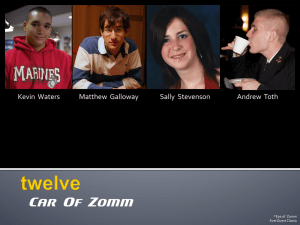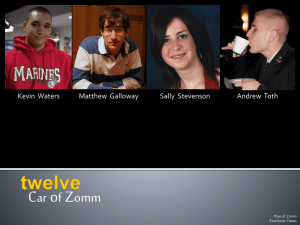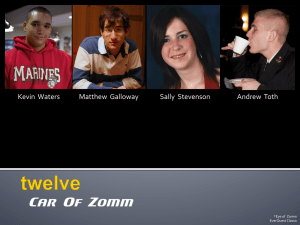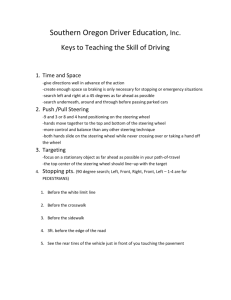Document 11380572
advertisement
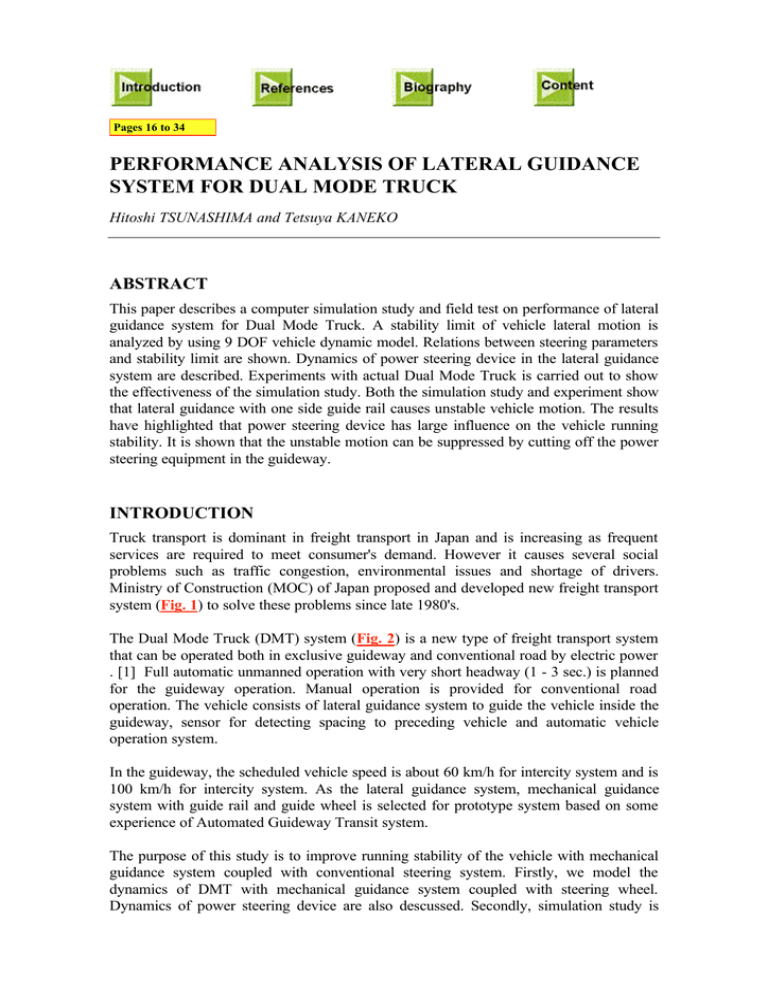
Pages 16 to 34
PERFORMANCE ANALYSIS OF LATERAL GUIDANCE
SYSTEM FOR DUAL MODE TRUCK
Hitoshi TSUNASHIMA and Tetsuya KANEKO
ABSTRACT
This paper describes a computer simulation study and field test on performance of lateral
guidance system for Dual Mode Truck. A stability limit of vehicle lateral motion is
analyzed by using 9 DOF vehicle dynamic model. Relations between steering parameters
and stability limit are shown. Dynamics of power steering device in the lateral guidance
system are described. Experiments with actual Dual Mode Truck is carried out to show
the effectiveness of the simulation study. Both the simulation study and experiment show
that lateral guidance with one side guide rail causes unstable vehicle motion. The results
have highlighted that power steering device has large influence on the vehicle running
stability. It is shown that the unstable motion can be suppressed by cutting off the power
steering equipment in the guideway.
INTRODUCTION
Truck transport is dominant in freight transport in Japan and is increasing as frequent
services are required to meet consumer's demand. However it causes several social
problems such as traffic congestion, environmental issues and shortage of drivers.
Ministry of Construction (MOC) of Japan proposed and developed new freight transport
system (Fig. 1) to solve these problems since late 1980's.
The Dual Mode Truck (DMT) system (Fig. 2) is a new type of freight transport system
that can be operated both in exclusive guideway and conventional road by electric power
. [1] Full automatic unmanned operation with very short headway (1 - 3 sec.) is planned
for the guideway operation. Manual operation is provided for conventional road
operation. The vehicle consists of lateral guidance system to guide the vehicle inside the
guideway, sensor for detecting spacing to preceding vehicle and automatic vehicle
operation system.
In the guideway, the scheduled vehicle speed is about 60 km/h for intercity system and is
100 km/h for intercity system. As the lateral guidance system, mechanical guidance
system with guide rail and guide wheel is selected for prototype system based on some
experience of Automated Guideway Transit system.
The purpose of this study is to improve running stability of the vehicle with mechanical
guidance system coupled with conventional steering system. Firstly, we model the
dynamics of DMT with mechanical guidance system coupled with steering wheel.
Dynamics of power steering device are also descussed. Secondly, simulation study is
carried out to show the vehicle performance in realistic situation. The relation between
vehicle stability limit and steering parameters is analyzed in this simulation study. We
carried out field test to confirm the results of the simulation study. Based on the
simulation study and the field test with prototype DMT, improvements of steering
system are proposed.
VEHICLE DYNAMIC MODEL
Nomenclature
ϕ : yaw angle
φ : roll angle of vehicle body
φ R : roll angle of rear axle
θ : steering wheel angle
m : vehicle total mass
mG : guide wheel mass
WF , WR : weight on front and rear axle
I φ : roll moment of inertia (body)
β : side slip angle
φ F : roll angle of front axle
δ : front wheel steering angle
V : vehicle forward velocity
mS : sprung mass
I φF : roll moment of inertia (front axle)
I φR : roll moment of inertia (rear axle)
I Z : yaw moment of inertia (body)
I ZF : lumped yaw moment of inertia of wheels and steering link
I SW : moment of inertia of steering wheel
K S : guide bar stiffness
KφF : roll stiffness of front suspension
KφR : roll stiffness of rear suspension KGW : guide wheel radial stiffness
K Z : tire vertical stiffness
CS : guide bar damping coefficient
K SW : torsional stiffness of steering shaft
CφF : front roll damping coefficient
CφR : rear roll damping coefficient
CSW : steering shaft damping coefficient
G F : steering gain
CC : cornering coefficient
n : steering gear ratio
t P : pneumatic trail
t C : caster trail
t d : front wheel tread
t d 0 : rear wheel outer tread
t dI : rear wheel inner tread
δ 0 : toe-in angle
hS : distance from roll axis to c.g
hF , hR : front and rear roll center height
M B : bias moment of steering system
M FRI : friction at king pin
M K : self aligning moment of steering stabilizer
M 0 : max. self aligning moment of steering stabilizer
y GR , y GL : lateral displacement of guide wheel
L f : distance from vehicle c.g. to front axle
Lr : distance from vehicle c.g. to rear axle
D : position of the guide wheel
ε : clearance between guide wheel and guideway
k t : torsion bar stiffness
C B : steering system damping coefficient
A p : effective area of ball nut
rC : pitch circle radius of sector gear
pe : pressure of power cylinder
g m : coefficient of flow rate
k v : coefficient of power steering fluid
rP : coefficient of control valve
Vehicle dynamic model without power steering model
The vehicle model for Dual Mode Truck is shown in Fig. 3. A mechanical guidance
system of the vehicle consists of a steering link, guide bar and two guide wheels which
contact to wayside guide rails. Front wheels connected with the mechanical guidance
system are allowed to rotate about king pins and a steering wheel connected to the
steering link through a modeled spring is also allowed to rotate about its axis. Further 2degree-of-freedom rotational motion of the steering system and lateral motions of the
guide wheels relative to the guide bar are assumed. [2]
1)
Vehicle side slip:
mV ( β& + ϕ& ) − ms hs φ&& = FF + FR + FG ,
(1)
where the cornering force and the force acting on guide bar are
FF = CC WF (δ − β − L f ϕ& / V ) + CC K Z t d δ 0 φ F ,
(2)
FR = CC WR ( − β + Lr ϕ& / V ) ,
FG = K S ( y GL + y GR ) + C S ( y& GL
2)
(3)
+ y& GR ) .
(4)
Rotational motion of front wheel:
I ZF (δ&& + ϕ&&) = FG / G F − (t p + t c ) FF − M B − M K − M FRI + nK SW (θ − nδ ) ,
(5)
where M K is self aligning moment of front wheel stabilizer given by
M K = M 0 sign(δ ) .
(6)
3)
Yawing motion of vehicle body:
I Z ϕ&& = L f ( FG + FF ) − Lr FR + M B + M K + M FRI + C SW θ& .
(7)
4)
Rolling motion of vehicle body:
Iφ φ&& = − KφF (φ − φF ) − KφR (φ − φR ) − CφF (φ& − φ&F ) − CφR (φ& − φ&R )
+ mS ghS φ + mS hS V ( β& + ϕ& ) .
(8)
5)
Rolling motion of unsprung mass:
I φF φ&&F = − KφF (φ F − φ ) − CφF (φ&F − φ& ) − K Z (t d2 / 2)φ F + h F FR ,
I φR φ&&R = − KφR (φ R − φ ) − CφR (φ&R − φ&) − K Z {( t d2 0 / 2) + ( t dI2 / 2)}φ R + h R FR .
(9)
(10)
6)
Motion of guide wheel:
mG &&y GL = − CS y& GL − K S y GL − [ KS KGW ε / ( K S + KGW )]*
+ GFGL − mG (ϕ&&F − ϕ&&) / G F − mGV ( β& + ϕ& ) − mG L f ϕ&& ,
(11)
mG &&y GR = − CS y& GR − K S y GR − [ K S K GW ε / ( K S + K GW )]*
+ GFGR − mG (ϕ&&F − ϕ&&) / G F − mGV ( β& + ϕ& ) − mG L f ϕ&& .
(12)
The * terms are considered for pre-loading( ε < 0 ). Moreover, GFGL and GFGR are the
force between the guide wheel and the guide rail.
7)
Motion of steering wheel:
I SW (θ&& + ϕ&&) = − K SW (θ − nδ ) − CSW θ& .
(13)
The vehicle motion can be simulated by obtaining the solution of these nonlinear
differential equation by using the Runge-Kutta-Gill method.
Dynamics of power steering system
We modeled the interacting effect of conventional steering system and the mechanical
guidance system by using the mechanical coupling as shown in Fig. 3. However,it is
expected that a power steering device, which is installed for DMT vehicle to control the
vehicle in conventional road by the driver, has large effect on the motion of the steering
system. The simplified dynamics of the power steering system can be described by
following equations.
I SW θ&& = − k t (θ − nδ ) − CSW θ& ,
(14)
I ZFδ&& = nk t (θ − nδ ) − CBδ& + Ap rC pe + TS ,
(15)
where TS is external torque acting at king pin.
p& e = − k v
rC
k
A p nδ& + k v gm(θ − nδ ) − v pe ,
n
rp
(16)
The relation between the power steering system and the DMT vehicle is shown in Fig.4.
SIMULATION RESULTS
The simulation was done based on the baseline vehicle configration shown in Table.1 and
guideway model shown in Fig.5.Here the effects of design parameters on the stability
limit of the vehicle was evaluated.
A steering gain ( G F ) determined by steering lever length of the mechanical guidance
system is one of the important steering parameters having a great influence upon the
vehicle stability. It is a ratio at which front wheels are steered depending on a unit
displacement of the guide wheel. The smaller the steering gain is, the greater lateral
displacement relative to the guideway is necessary for the vehicle to pass through at the
curved guideway, consequently, the wider guideway is required, however, the larger
steering gain reduces the vehicle stability limit.
The DMT vehicle has the simple guidance system where the steering gain is determined
by the position of the guide wheel. The running stability of the vehicle changes largely
because the steering gain changes by the sensing point. Figure 6 (a) shows the effect of
sensing point on the stability limit. It is shown that the longer guide arm can improve the
vehicle stability, however, consideration for curved guideway is also necessary to
determine the optimum. Figure 6 (a) also shows the influence of clearance between guide
wheel and guideway. The stability limit of the vehicle can be improved by the small
clearance or pre-load of guide wheel. However, the clearance should be limited from
respect of guide rail precision.
The DMT vehicle has steering wheel because the manual operation is required at
conventional load. When running on the exclusive guideway, the steering wheel is forced
to rotate by the mechanical guidance system. Figure 6 (b) shows the effect of steering
wheel on the stability limit. It is shown that the steering wheel deteriorate the stability of
Table 1 Baseline vehicle configuration
m
6450.0
[kg]
CφF , CφR
9.8
[kNms / rad]
Lf
2.23
[ m]
hS
0.7
[m]
Lr
D
ε
n
IZ
1.12
0.5
0.005
25.0
7460.0
KφF , KφR
KZ
KGW
[kgm 2 ]
mG
0.5
[kg]
0.061 [kgm ]
CS
9.8
[Ns / m]
[kgm 2 ]
KS
294.0
[kN / m]
[kgms 2 ]
2940.0
58.8
I φF
I φR
[kgm 2 ]
2
I SW
Iφ
hF , hR
WF
WR
CC
9.8
I ZF
0.6
21.1
42.1
4.22
294.0
[m]
[m]
[m]
294.0
98.0
196.0
[m]
[kN]
[kN]
[1 / rad]
[kN / m]
td , td 0
1.63
[m]
2
[kgm ]
t dI
1.12
[m]
[kNm / rad]
tp
0.042
[m]
[kN / m]
the DMT vehicle. It is necessary to control the motion of the steering wheel to achieve a
high-speed running of the vehicle in the guideway from this and not effect the steering
system as much as possible.
FIELD TEST
The prototype DMT vehicle and test track
To examine the running stability of a real DMT vehicle, the running characteristic of the
prototype DMT test vehicle was measured on the DMT field test course in Pubic Works
Research Institute, Ministry of Construction (Fig. 7). The test course (Total; length
760m) is composed of the curve section (Section 1 and Section 3: radius 65 m), the
straight section (Section 3: grade 6%), the switching section (Section 4 and 5). The
design maximum speed in the guideway is about 40 km/h.
Unstable motion in the field test
Figure 8 shows the data of speed, yaw rate, and steering wheel angle of the DMT
experiment vehicle on the guideway running. In Fig. 8, the motion of the vehicle is
unstable in the latter half in curve section (Section 1) and switching section (Section 4).
On the other hand, in the curve section with the same radius (section 3), unstable motion
is not appeared under similar running condition. In the straight section (section 2), the
unstable motion is not appeared when the running speed is higher than the curve section.
Single-side guidance simulation
The steering stabilizer by the self aligning moment is equipped in the prototype DMT
vehicle. At the curved guideway, vehicle is guided by outside guide rail with the steering
stabilizer as shown in Fig. 9. It is expected that the unstable motion is caused by singleside guidance. To confirm the unstable motion in the field test by the simulation, a
running simulation with single side guide rail is carried out. Here, the single side
guidance is realized by bias steering moment as shown in Fig. 9. The simulation results
are shown in Fig. 10. In Fig. 10, we can see that the unstable motion is caused by single
side guidance depending on the disturbance from the guideway. It is also shown that the
damping factor in steering shaft is effective for avoiding the unstable motion caused by
single-side guidance.
Field test results without power steering
The power steering device is installed in the prototype DMT vehicle as shown in Fig.4. It
is expected that the power steering device has large influence on the motion of
mechanical guidance system. We carried out the field test without power steering device
in the guideway. Figure 11 shows the experiment results without the power steering
device. We can see that the unstable motion of the vehicle in the guideway disappeared.
We can conclude that improvement of the vehicle stability in the single guidance situation
can be realized by cutting off the power steering device in the guideway operation.
CONCLUSIONS
The conclusions of this study are summarized as follows.
1) Avoiding the coupling effect between steering wheel and mechanical guidance system
is the most effective for high speed vehicle operation
2) The stability limit of the vehicle improves largely by moving the position of the guide
wheel forward.
3) The simulation study and the filed test shows that the single side guidance situation
causes the unstable motion of the vehicle even in low speed operation.
4) Cutting of the power steering device in guideway operation is effective for avoiding
the unstable motion caused by single side guidance.
REFERENCES
[1] Yamada, H. (1995) "Development of the New Freight Transport System and Its
Application on the Metropolitan Area and the Inter-City Transport", Proc. of ITS '95,
Japan, Yokohama, 9 - 11 November, p. 911.
[2] Abe, M. et al (1987) "A Study on the Performance of Guideway Bus Steering
Control System", Proc. of SAE 4th Int. Conf. on Automotive Engineering, pp. 231.1 231.8.
AUTHOR BIOGRAPHIES
Hitoshi TSUNASHIMA, Dr. Eng.
Assistant Professor,
Department of Mechanical Engineering, College of Industrial
Technology Nihon University
1-2-1 Iumi-cho,Narashino-shi,Chiba 275,Japan
e-mail : tsuna@me.cit.nihon-u.ac.jp
Born in 1959
1993-ME, University of Osaka Prefecture, Joined Kobe Steel Ltd.
1993-Recieved 1992 SAE Vincent Bendix Automotive
ElectronicsEngineering Award.
1993-Visiting Researcher, The University of Tokyo
1995-Dr. Eng., The University of Tokyo
1996-Assistant Professor of Nihon University
Member of The Japan Society of Mechanical Engineers, International
Association for Vehicle System Dynamics, The Japan Society of
Automotive Engineers
Tetsuya KANEKO
Department of Mechanical Engineering, College of Industrial
Technology Nihon University
e-mail : c71080@ccu.cit.nihon-u.ac.jp
Born in 1973
1997-BE, Nihon University
Graduate school student, Nihon University
Member of The Japan Society of Automotive Engineers
Figure 1 New freight transport system
Figure 2 Dual mode truck
Figure 3 Vehicle model with mechanical guidance system
Figure 4 Vehicle model with power steering system
Figure 5 Guideway model
(a) Effect of sensing point
Figure 6 Simulated unstable motion in
single-side guidance
(b) Effect of steering wheel
Figure 6 Simulated unstable motion in
single-side guidance
Figure 7 The prototype DMT test vehicle and test track
Figure 8 Results of field test (with power steering)
(a) Effect of guideway disturbance
(b)Effect of damping factor around
Figure 9 Single-side guidance at curved guideway and a model for single-side
guidance
Figure 10 Simulated unstable motion in single-side guidance
Figure 11 Result of field test (without power steering)
